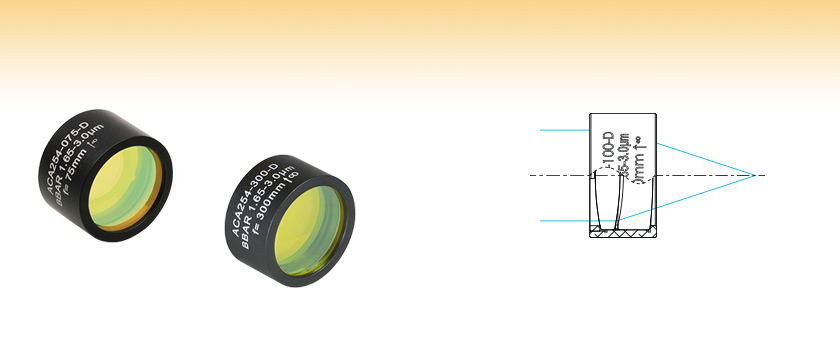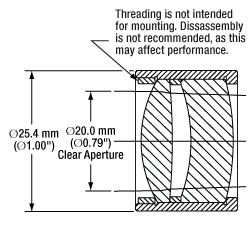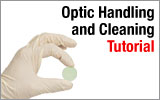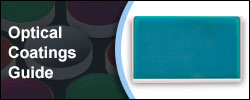IR Air-Spaced Achromatic Doublets Optimized for 1.65 - 3.0 µm

- AR Coating for 1.65 - 3.0 µm
- Design Wavelengths at 1.65 µm, 2.3 µm, and 3.0 µm
- 1" Outer Diameter Aluminum Housing
ACA254-075-D
ACA254-300-D

Please Wait
| Common Specifications | |
|---|---|
| Design Wavelengths | 1.65 µm, 2.3 µm, and 3.0 µm |
| Antireflection Coating | Ravg < 1.0% from 1.65 to 3.0 µm, 0° AOI |
| Clear Aperture | >Ø20 mm |
| Design RMS Wavefront Error | <λ/8 |
| Surface Quality | 40-20 Scratch-Dig |
| Focal Length Tolerance | ±1% at 2.3 µm |
| Substrate | CaF2 and Infrasil 302 |
| Housing Diameter | Ø1" (Ø25.4 mm) |
| Housing Diameter Tolerance | +0"/-0.002" (+0 mm/-0.05 mm) |
| Housing Length Tolerance | ±0.005" (±0.13 mm) |
Features
- Air-Spaced Doublet Design Provides Superior Aberration Performance than Singlet Lenses
- AR Coated for the 1.65 - 3.0 µm Range
- Designs Incorporate Calcium Fluoride (CaF2) and Infrasil 302 Substrates
- Mounted in Engraved Ø1" Aluminum Housings
These AR-coated, air-spaced achromatic doublet lenses provide excellent transmission in the 1.65 - 3.0 µm range (transmission can be seen in the graphs below). They incorporate two AR-coated lenses, one with a calcium fluoride substrate and another with an Infrasil 302 substrate.
Each achromatic doublet on this page has three design wavelengths: 1.65 µm, 2.3 µm, and 3.0 µm. By optimizing the design for these three wavelengths, the focal shift across the 1.65 - 3.0 µm range will be minimized, providing excellent on-axis performance. Note that since optical cement absorbs IR light, these doublets have an air-spaced design.
Thorlabs' IR achromatic doublets are pre-mounted in engraved Ø1" housings, making them easy to incorporate these optics into your setup. Each engraving includes the part number, AR coating range, focal length, an arrow indicating the direction of light propagation to collimate a point source, and an infinity symbol denoting that this lens has an infinite conjugate ratio (i.e., if a diverging light source is placed one focal length away from the flat side of the lens, the light rays emerging from the curved side will be collimated).
Note: We do not recommend disassembly of these lenses, as this may affect performance.
| Click on the red Document icon next to the item numbers below to access the Zemax file download. Our entire Zemax Catalog is also available. |
| Air-Spaced Doublets Selection Guide | |
|---|---|
| UV (245 - 400 nm) | D (1.65 - 3 µm) |
| Visible (350 - 700 nm) | E (3 - 5 µm) |
| NIR (650 - 1050 nm) | E3 (7 - 12 µm) |
| Laser-Line (532 & 1064 nm) | |
| Posted Comments: | |
John Flint
(posted 2022-04-07 10:47:16.807) any idea on the power handling at 2 microns? Substrates should be good but the coatings will heat up, leading to a focal shift as a function of power. Thanks! cdolbashian
(posted 2022-04-20 04:46:31.0) Thank you for reaching out to us John,
It is very likely that these coatings will absorb and transfer heat to the lens substrate itself, and subsequently cause some sort of thermal lensing. Unfortunately though, we do not have an estimate for the degree of index, and therefore focal length, shift for a 2um beam for a given power. |

 Products Home
Products Home








 Air-Spaced Achromatic Doublets (-D Coated)
Air-Spaced Achromatic Doublets (-D Coated)